Development and Testing of a Clear-Sky Data Selection Algorithm for FY-3C/D Microwave Temperature Sounder-2
Abstract
1. Introduction
2. Data and Model
3. Channel Characteristics and Data Collocation
4. Bias Correction of O-B
5. Cloud Detection Scheme
6. Typhoon Halong
7. Discussion and Conclusions
Author Contributions
Funding
Acknowledgments
Conflicts of Interest
References
- Lu, Q.F.; Lawrence, H.; Bormann, N.; English, S.; Lean, K.; Atkinson, N.; Bell, W.; Carminati, F. An evaluation of FY-3C satellite data quality at ECMWF and the Met Office. ECMWF Tech. Memo. 2015, 767, 35. [Google Scholar]
- Carminati, F.; Candy, B.; Bell, W.; Atkinson, N. Assessment and assimilation of FY-3 humidity sounders and imager in the UK Met Office global model. Adv. Atmos. Sci. 2018, 35, 942–954. [Google Scholar] [CrossRef]
- Zou, X.; Weng, F.; Zhang, B.; Lin, L.; Qin, Z.; Tallapragada, V. Impacts of assimilation of ATMS data in HWRF on track and intensity forecasts of 2012 four landfall hurricanes. J. Geophys. Res. Atmos. 2013, 118, 11–558. [Google Scholar] [CrossRef]
- Tian, X.X.; Zou, X.L.; Yang, S.P. A limb correction method for the Microwave Temperature Sounder 2 and its applications. Adv. Atmos. Sci. 2018, 35, 1547–1552. [Google Scholar] [CrossRef]
- Zou, X.; Wang, X.; Weng, F.; Li, G. Assessments of Chinese FengYun microwave temperature sounder (MWTS) measurements for weather and climate applications. J. Atmos. Oceanic Technol. 2011, 28, 1206–1227. [Google Scholar] [CrossRef]
- McNally, A.P.; Derber, J.C.; Wu, W.; Katz, B.B. The use of TOVS Level-1B radiances in the NCEP SSI analysis system. Quart. J. Roy. Meteor. Soc. 2000, 126, 689–724. [Google Scholar] [CrossRef]
- Li, J.; Zou, X. Impact of FY-3A MWTS radiances on prediction in GRAPES with comparison of two quality control schemes. Front. Earth Sci. 2014, PRC 8, 251–263. [Google Scholar] [CrossRef]
- Dee, D.P. Bias and data assimilation. Quart. J. Roy. Meteor. Soc. 2005, 131, 3323–3343. [Google Scholar] [CrossRef]
- Auligné, T.; McNally, A.P.; Dee, D.P. Adaptive bias correction for satellite data in a numerical weather prediction system. Quart. J. Roy. Meteor. Soc. 2007, 133, 631–642. [Google Scholar] [CrossRef]
- Amerault, C.; Zou, X. Comparison of observed and model-simulated microwave radiance in hurricane environment and estimate of background error covariances for hydrometeor variables. Mon. Wea. Rev. 2006, 134, 745–758. [Google Scholar] [CrossRef]
- Saunders, R.; Hocking, J.; Turner, E.; Rayer, P.; Rundle, D.; Brunel, P.; Vidot, J.; Rocquet, P.; Matricardi, M.; Geer, A.; et al. An update on the RTTOV fast radiative transfer model (currently at version 12). Geosci. Model Dev. 2018, 11, 2717–2737. [Google Scholar] [CrossRef]
- Geer, A.J.; Bauer, P.; English, S. Assimilating AMSU-A temperature sounding channels in the presence of cloud and precipitation. ECMWF Tech. Memo. 2012, 670, 41. [Google Scholar]
- Zhu, Y.; Derber, J.; Collard, A.; Dee, D.; Treadon, R.; Gayno, G.; Jung, J.A. Enhanced radiance bias correction in the National Centers for Environmental Prediction’s Gridpoint Statistical Interpolation data assimilation system. Quart. J. Roy. Meteor. Soc. 2014, 140, 1479–1492. [Google Scholar] [CrossRef]
- Migliorini, S.; Candy, B. All-sky satellite data assimilation of microwave temperature sounding channels at the Met Office. Quart. J. Roy. Meteor. Soc. 2019, 145, 867–883. [Google Scholar] [CrossRef]
- Grody, N.; Zhao, J.; Ferraro, R.; Weng, F.; Boers, R. Determination of precipitable water and cloud liquid water over oceans from the NOAA-15 advanced microwave sounding unit. J. Geophys. Res. Atmos. 2001, 106, 2943–2953. [Google Scholar] [CrossRef]
- Li, J.; Zou, X. A quality control procedure for FY-3A MWTS measurements with emphasis on cloud detection using VIRR cloud fraction. J. Atmos. Oceanic Technol. 2013, 30, 1704–1715. [Google Scholar] [CrossRef][Green Version]
- Li, J.; Liu, G.Q. Direct assimilation of Chinese FY-3C Microwave Temperature Sounder-2 radiances in the global GRAPES system. Atmos. Meas. Tech. 2016, 9, 3095–3113. [Google Scholar] [CrossRef]
- Qin, L.; Chen, Y.; Yu, T.; Ma, G.; Guo, Y.; Zhang, P. Dynamic channel selection of microwave temperature sounding channels under cloudy conditions. Remote Sens. 2020, 12, 403. [Google Scholar] [CrossRef]
- Han, H.; Li, J.; Goldberg, M.; Wang, P.; Li, J.; Li, Z.; Sohn, B.-J.; Li, J. Microwave sounder cloud detection using a collocated high-resolution imager and its impact on radiance assimilation in tropical cyclone forecasts. Mon. Wea. Rev. 2015, 144, 3937–3959. [Google Scholar] [CrossRef]
- Niu, Z.; Zou, X. Development of a new algorithm to identify clear-sky MSU data using AMSU-A data for verification. IEEE Trans. Geosci. Remote Sens. 2018, 57, 700–708. [Google Scholar] [CrossRef]
- Liu, Q.; Weng, F. A microwave polarimetric two-stream radiative transfer model. J. Atmos. Sci. 2002, 59, 2396–2402. [Google Scholar] [CrossRef]
- Clough, S.A.; Shephard, M.W.; Mlawer, E.J.; Delamere, J.S.; Iacono, M.J.; Cady-Pereira, K.; Boukabara, S.; Brown, P.D. Atmospheric radiative transfer modeling: A summary of the AER codes. J. Quant. Spectrosc. Radiat. Transf. 2005, 91, 233–244. [Google Scholar] [CrossRef]
- Zou, X.; Lin, L.; Weng, F. Absolute calibration of ATMS upper level temperature sounding channels using GPS RO observations. IEEE Trans. Geosci. Remote Sens. 2014, 52, 1397–1406. [Google Scholar] [CrossRef]
- Li, X.; Zou, X. Bias characterization of CrIS radiance at 399 selected channels with respect to NWP model simulation. Atmos. Res. 2017, 196, 164–181. [Google Scholar] [CrossRef]
- Wang, X.; Zou, X. An assessment of the FY-3A Microwave Temperature Sounder using the NCEP numerical weather prediction model. IEEE Trans. Geosci. Remote Sens. 2012, 50, 4860–4874. [Google Scholar] [CrossRef]
- Zou, C.-Z.; Wang, W.; Wang, L.; Long, C. Recalibration and merging of SSU observations for stratospheric temperature trend studies. J. Geophys. Res. Atmos. 2016, 119, 13–180. [Google Scholar] [CrossRef]
- Li, X.; Zou, X. An alternative bias correction scheme for CrIS data assimilation in regional model. Mon. Weather Rev. 2019, 147, 809–839. [Google Scholar] [CrossRef]
- Zhuge, X.; Zou, X. Test of a modified infrared only ABI cloud mask algorithm for AHI radiance observations. J. App. Meteor. Climatol. 2016, 55, 2529–2546. [Google Scholar] [CrossRef]
- Ying, M.; Zhang, W.; Yu, H.; Lu, X.; Feng, J.; Fan, Y.; Zhu, Y.; Chen, D. An overview of the China Meteorological Administration tropical cyclone database. J. Atmos. Oceanic Technol. 2014, 31, 287–301. [Google Scholar] [CrossRef]
- Zhang, L.; Liu, Y.; Liu, Y.; Gong, J.; Lu, H.; Jin, Z.; Tian, W.; Liu, G.; Zhou, B.; Zhao, B. The operational global four-dimensional variational data assimilation system at the China Meteorological Administration. Quart. J. Roy. Meteor. Soc. 2019, 145, 1882–1896. [Google Scholar] [CrossRef]
- Weng, F.; Zou, X.; Qin, Z. Uncertainty of AMSU-A derived temperature trends in relationship with clouds and precipitation. Clim. Dyn. 2014, 43, 1439–1448. [Google Scholar] [CrossRef]
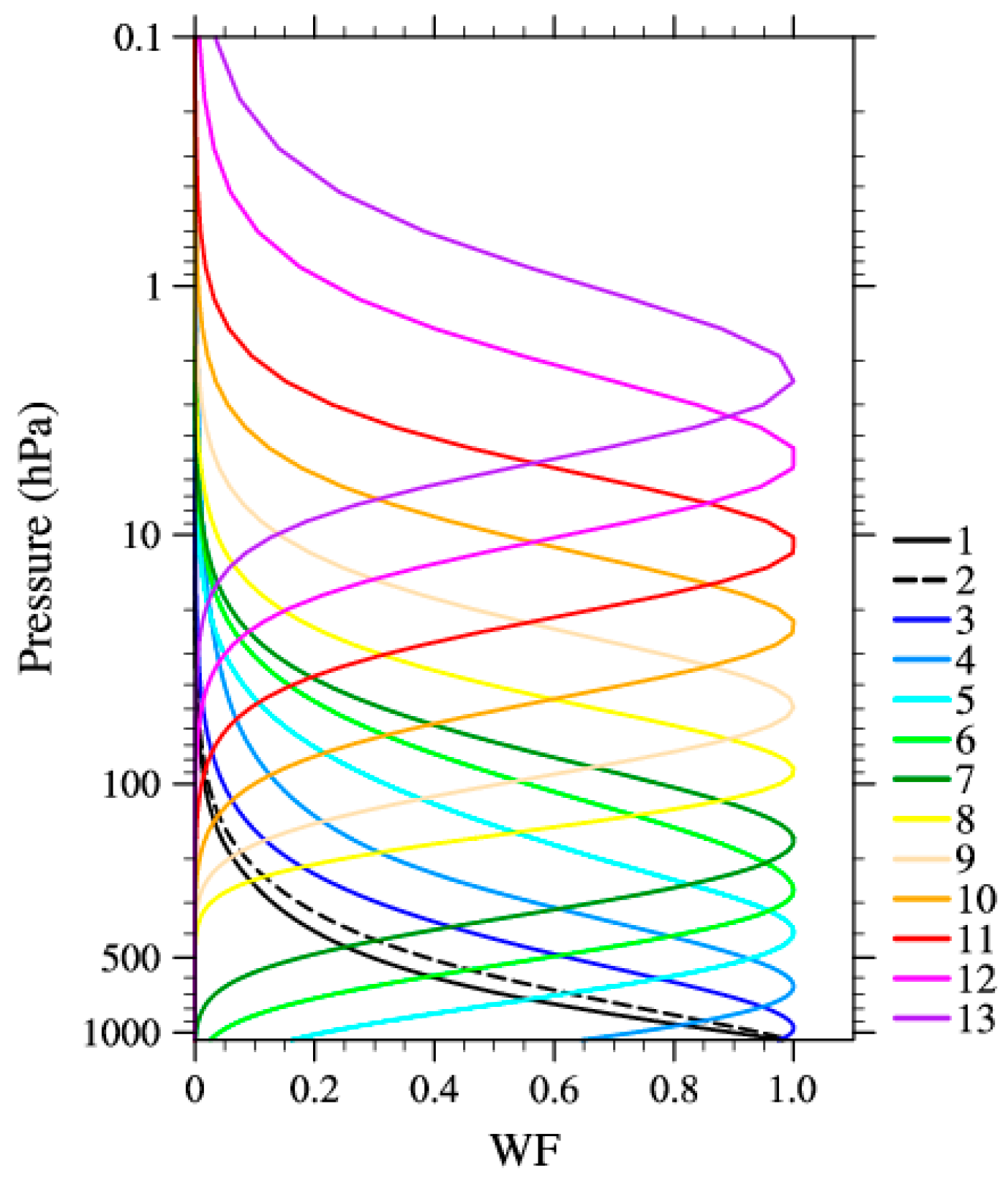
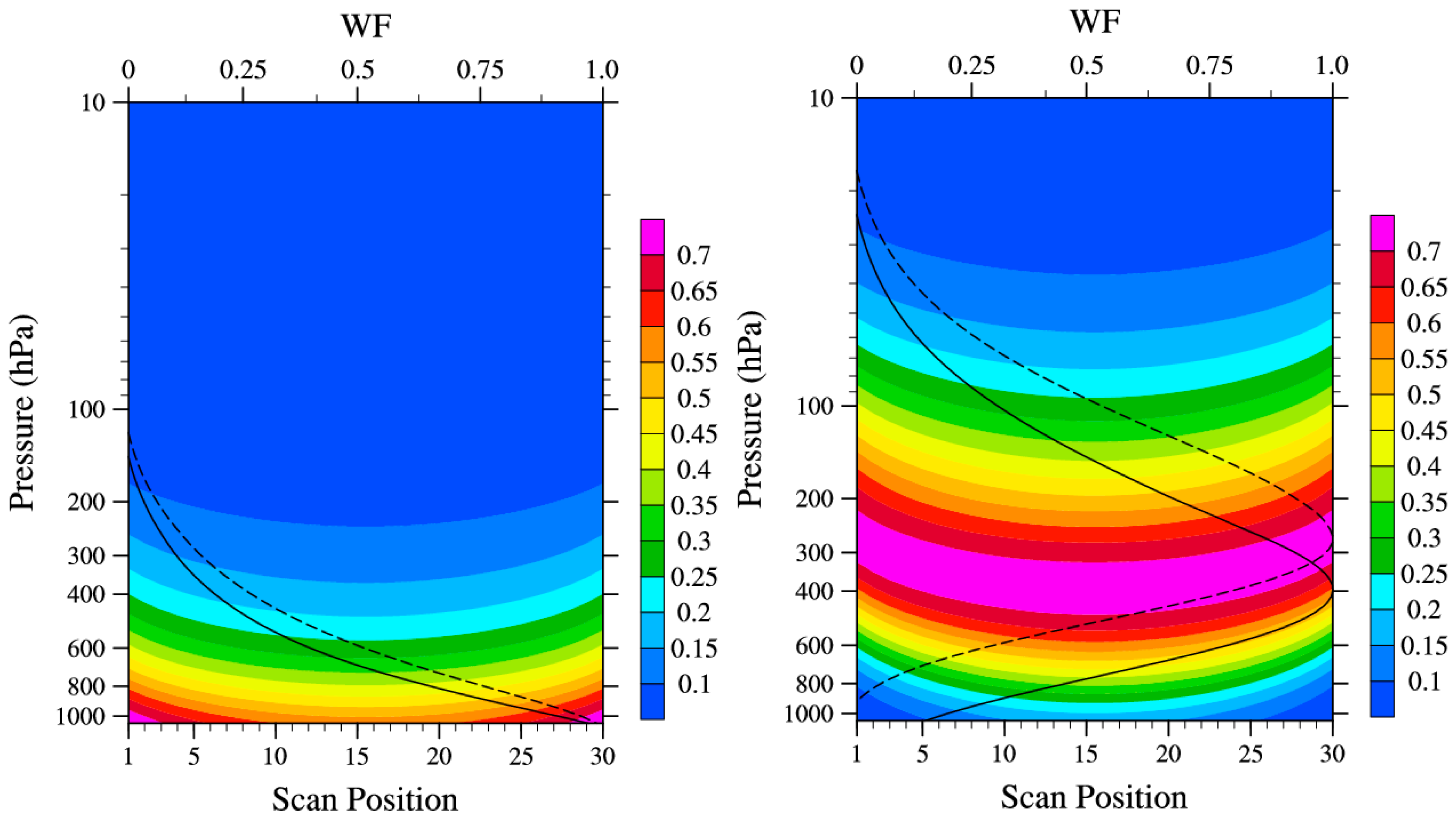

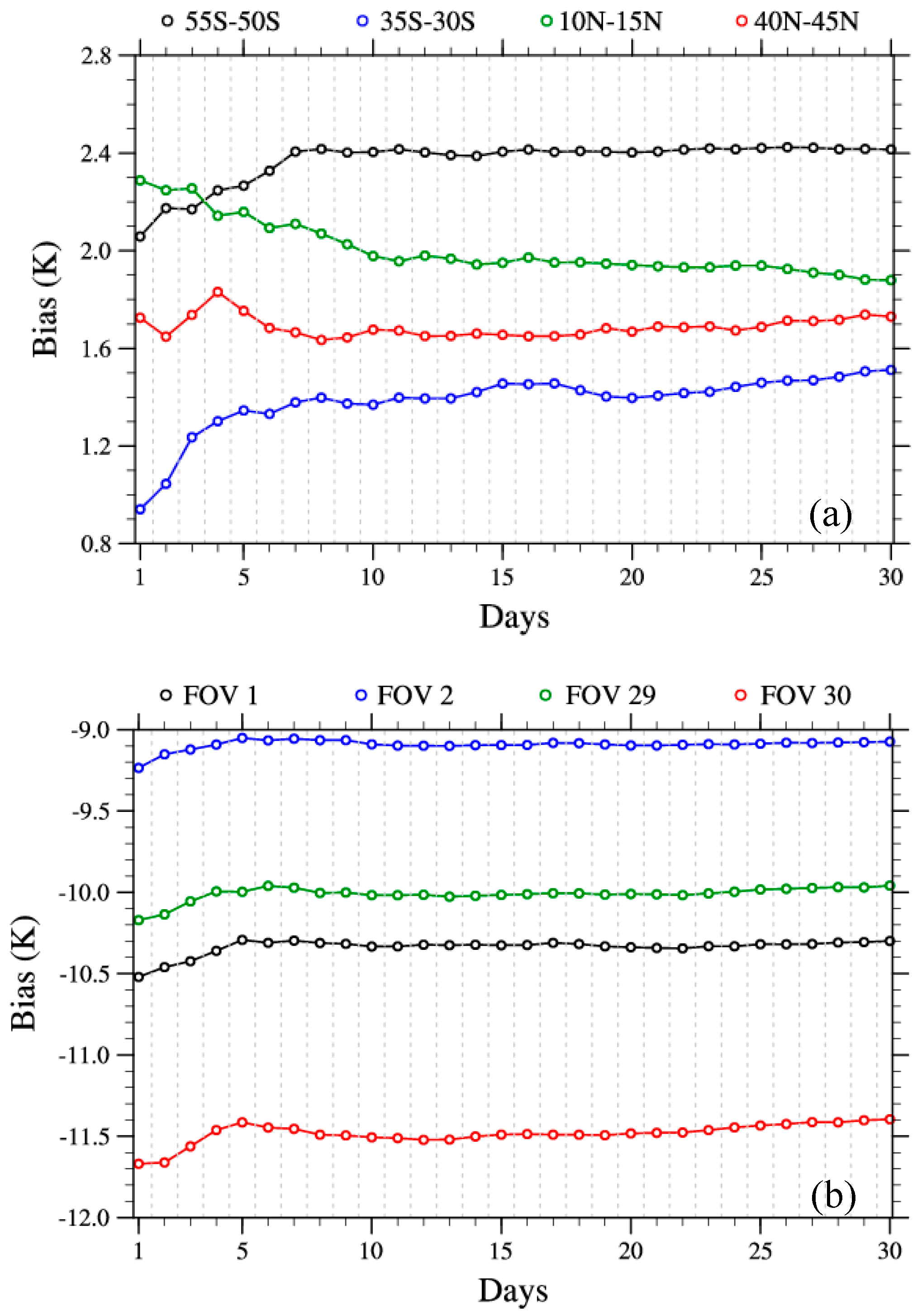
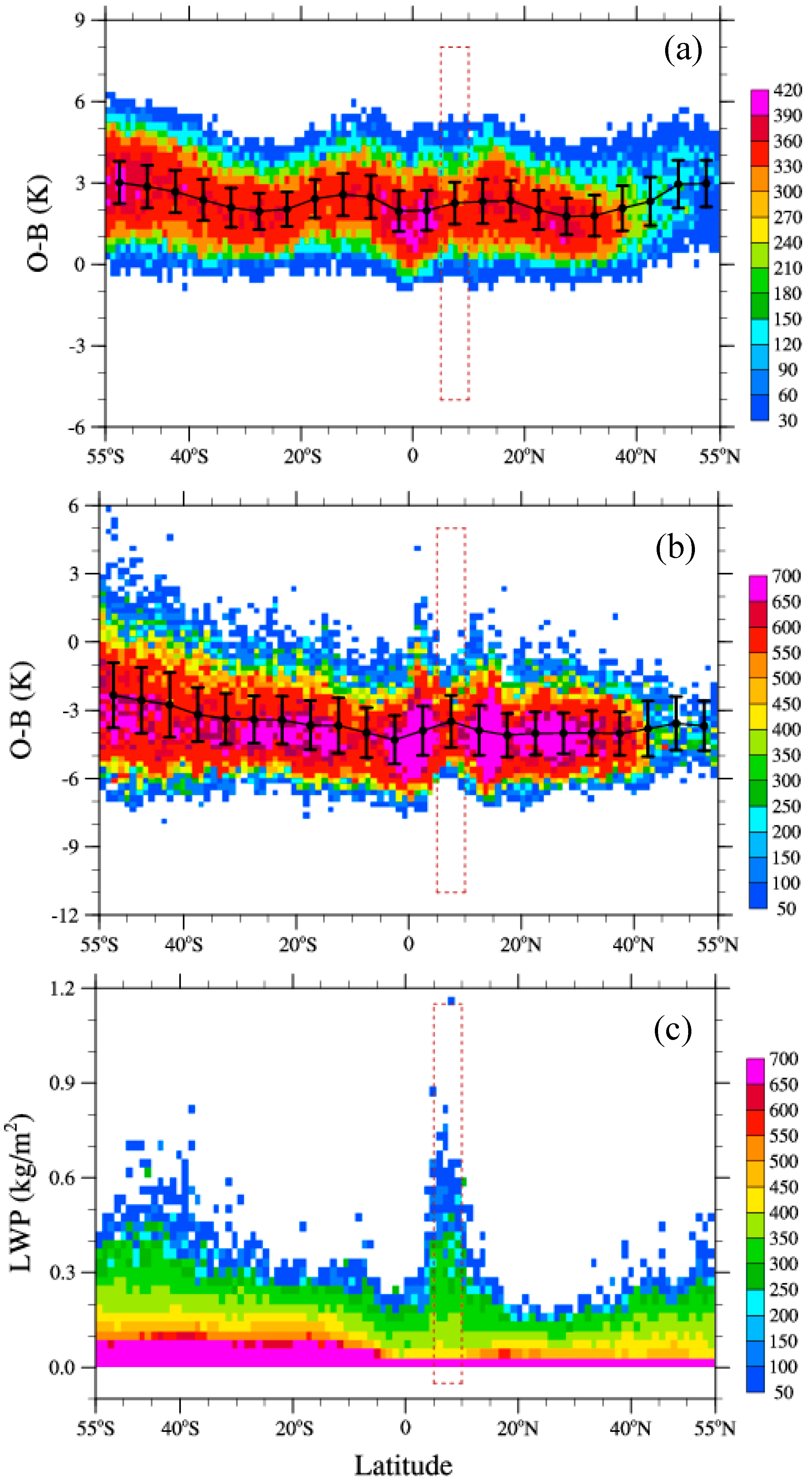
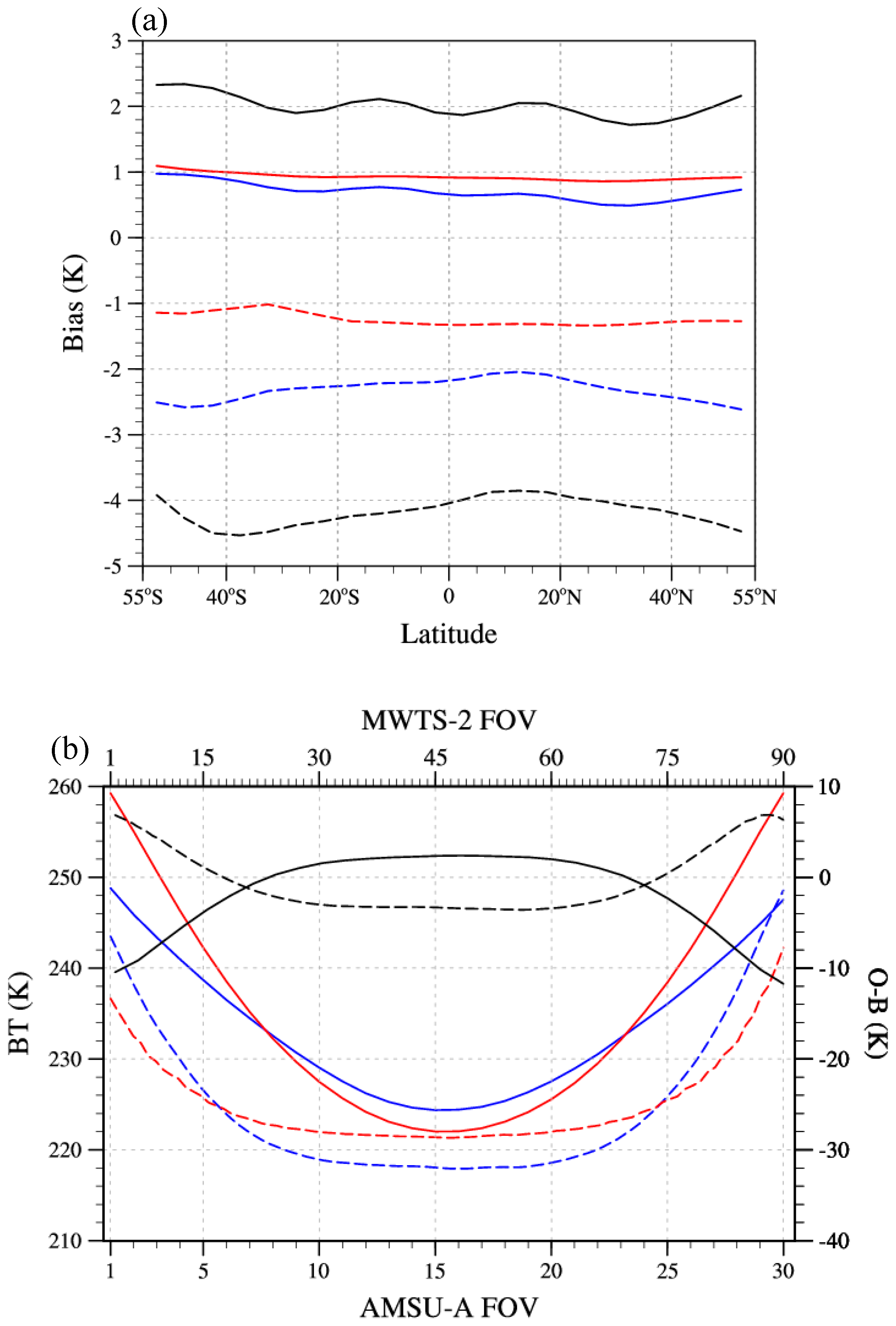


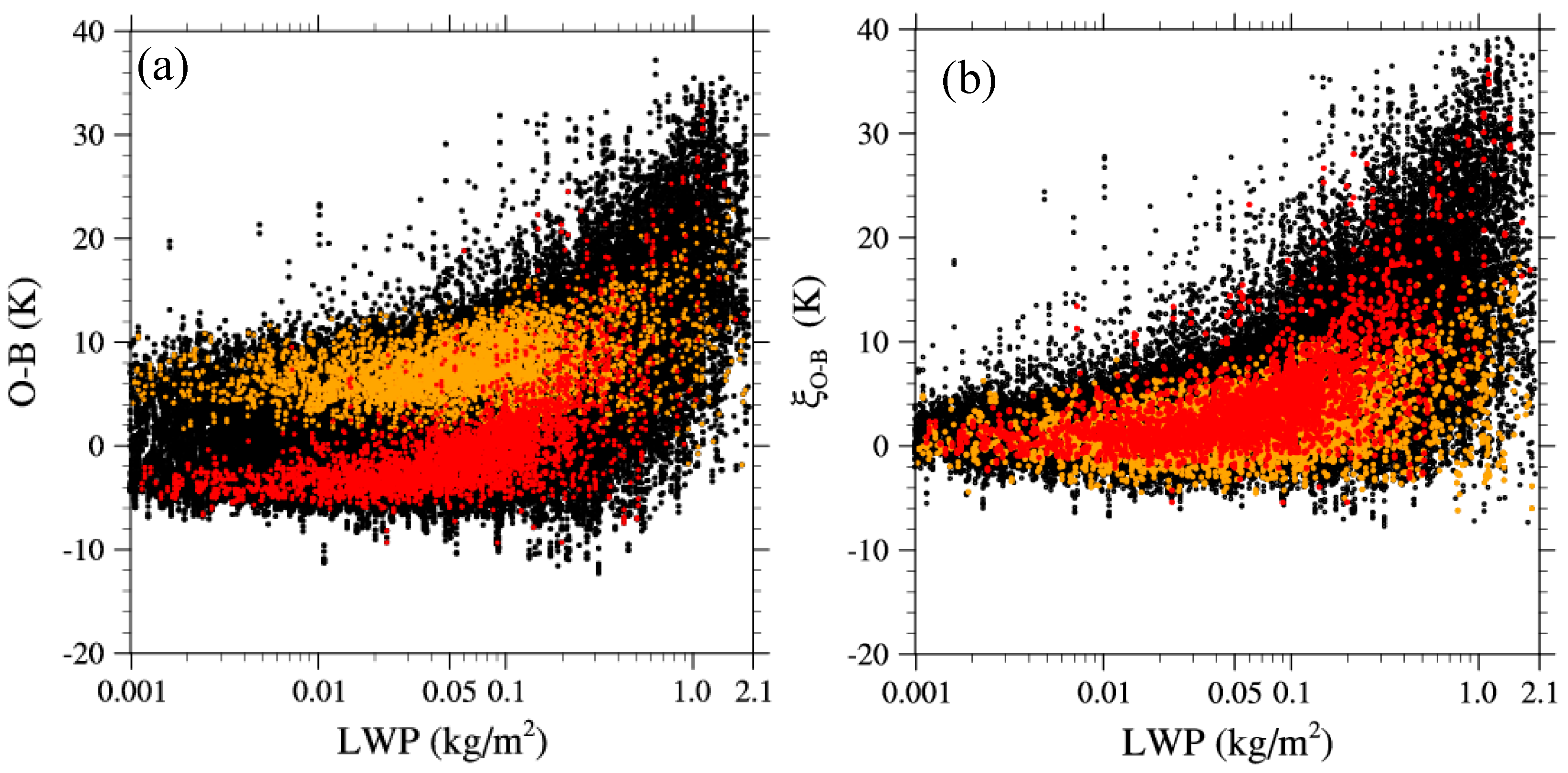
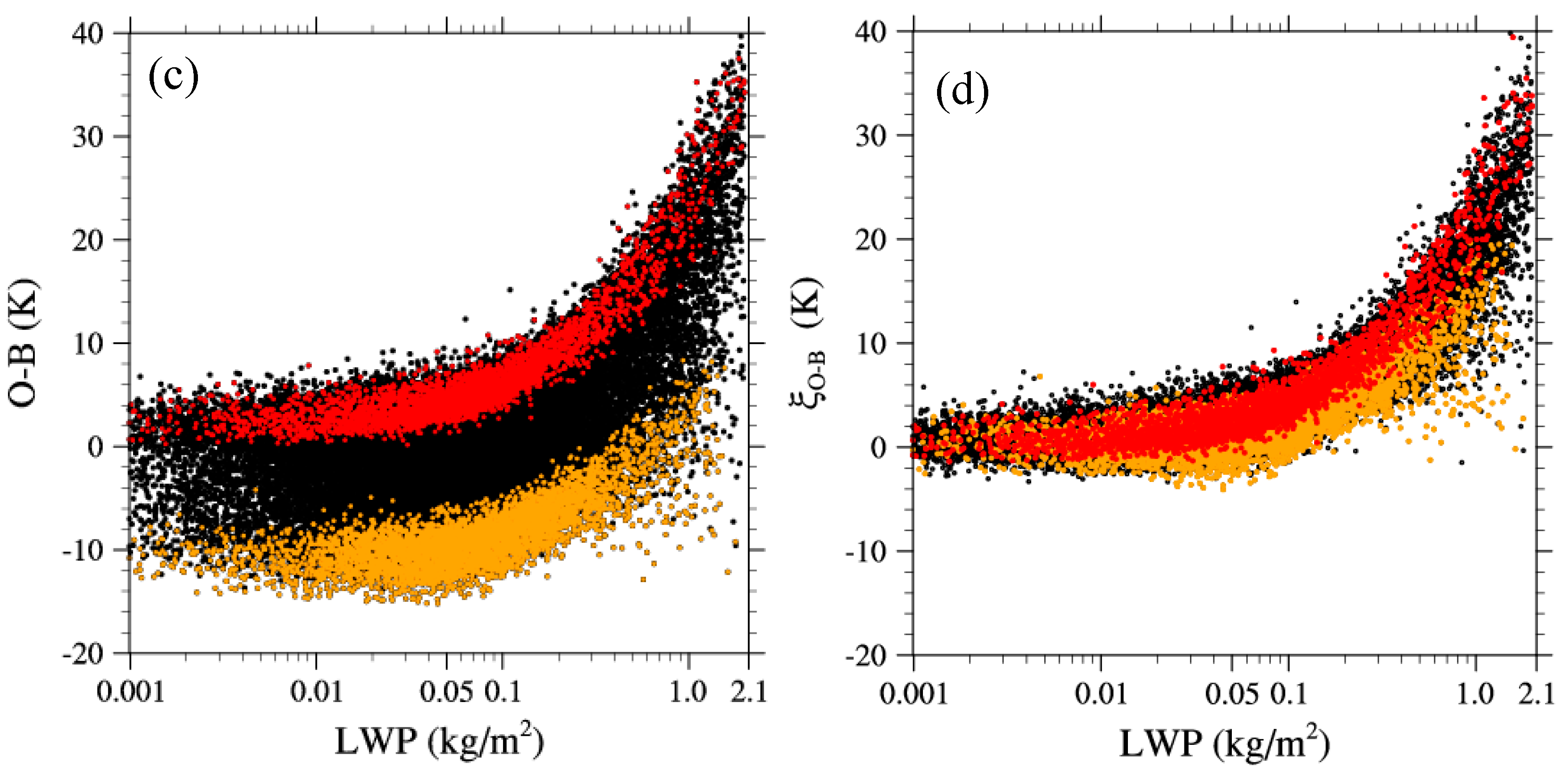
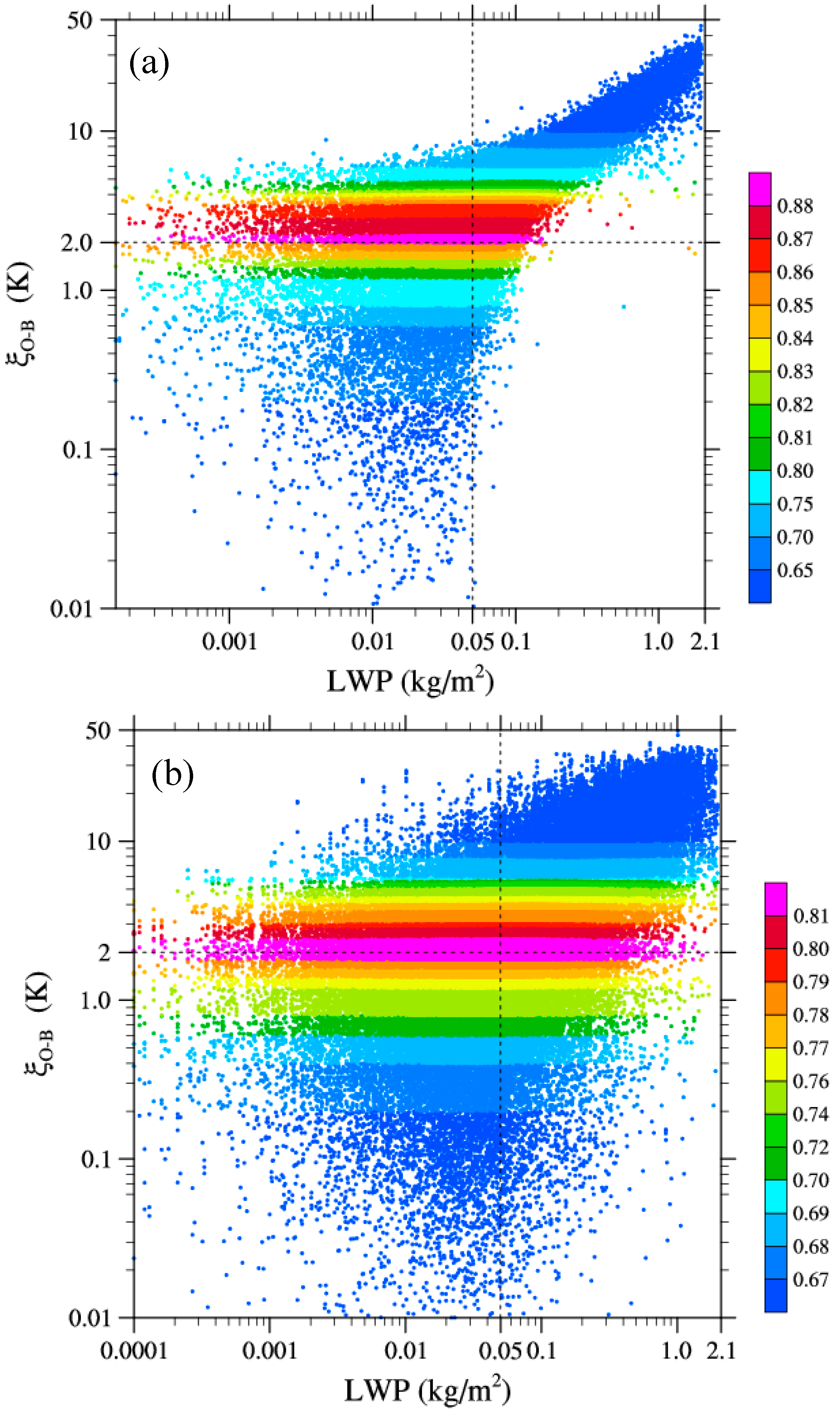

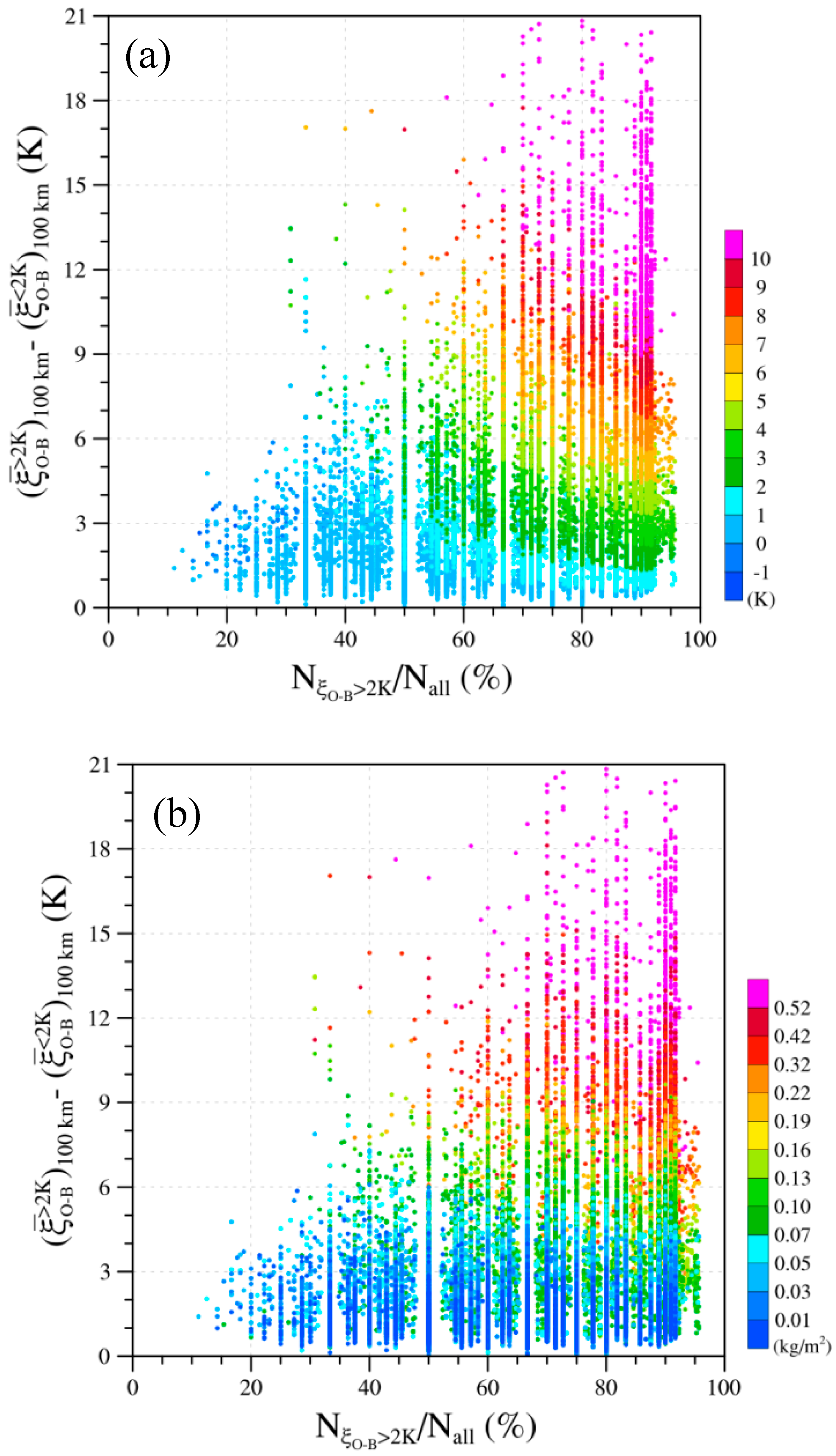

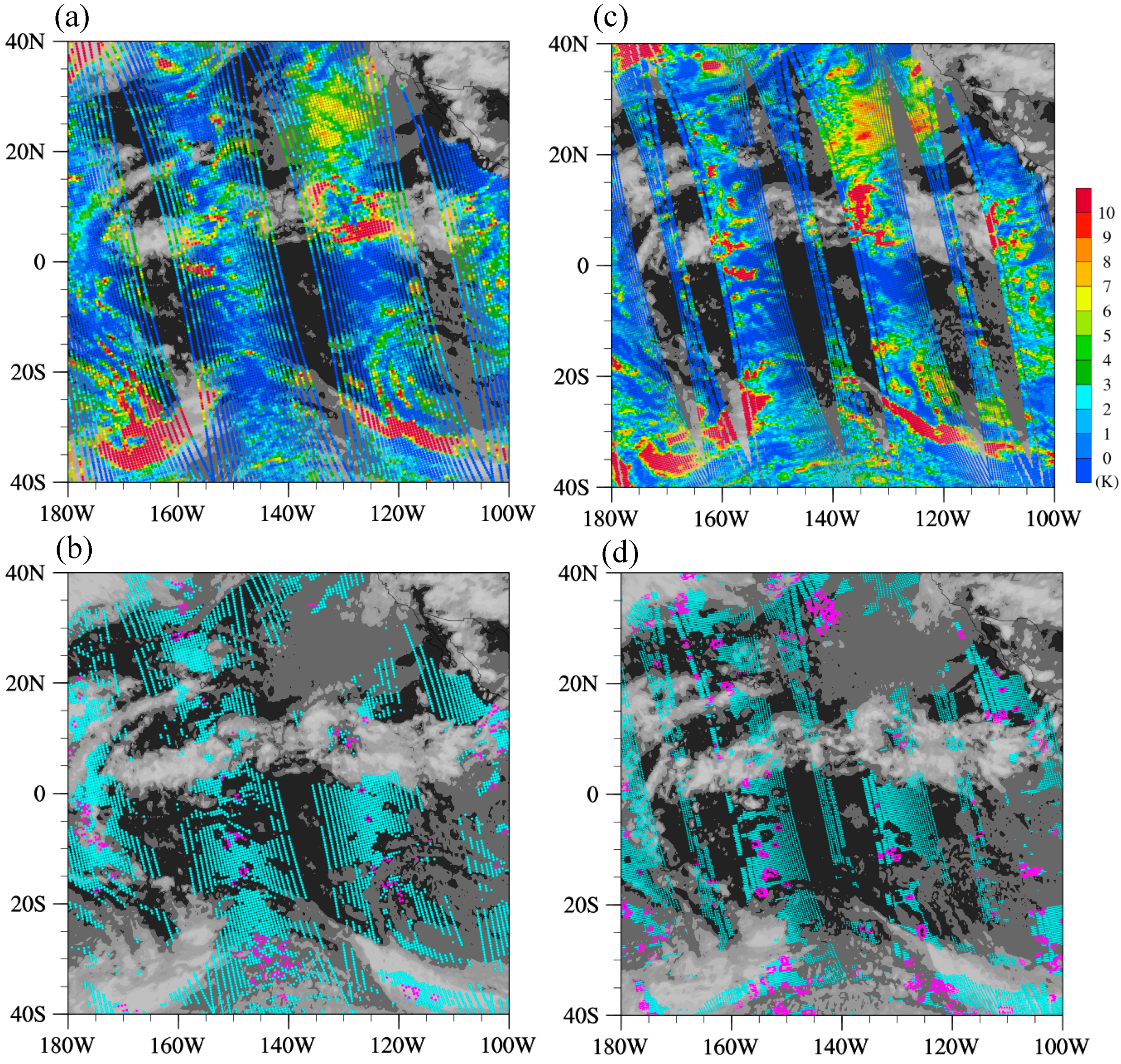

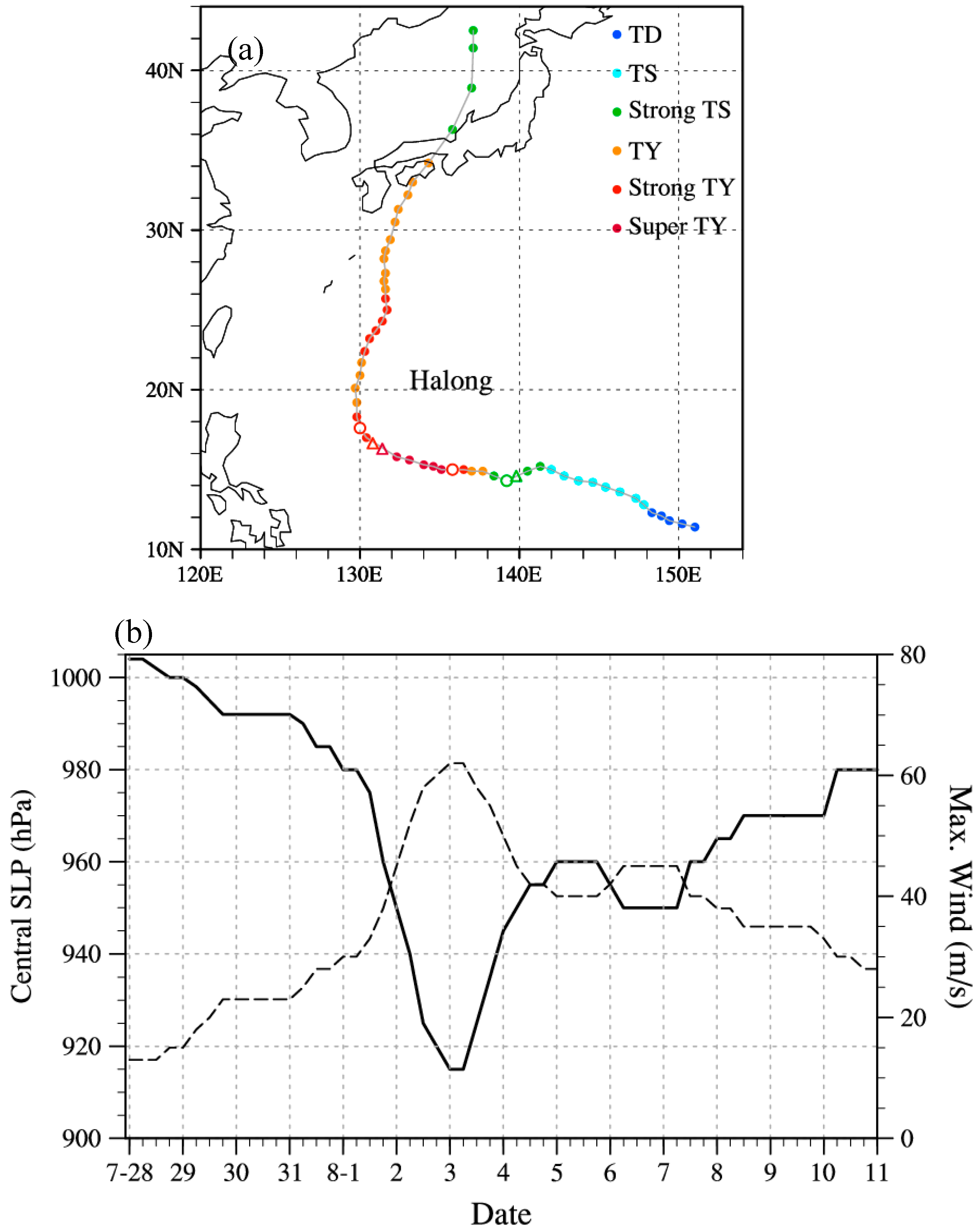

| Channel No. | Frequency (GHz) | NEDT (K) | Bandwidth (MHz) | WFP (hPa) | |||
|---|---|---|---|---|---|---|---|
| AMSU/MWTS | AMSU | MWTS | AMSU | MWTS | AMSU | MWTS | |
| 1/- | 23.8(V) | - | 0.30 | - | 270 | - | 1085 |
| 2/- | 31.4(V) | - | 0.30 | - | 180 | - | 1085 |
| 3/1 | 50.30(V) | 50.30(H) | 0.40 | 1.20 | 180 | 180 | 1085 |
| -/2 | - | 51.76(H) | - | 0.75 | - | 400 | 950 |
| 4/3 | 52.80(V) | 52.80(H) | 0.25 | 0.75 | 400 | 400 | 850 |
| 5/4 | 53.596(H) | 0.25 | 0.75 | 170 | 400 | 700 | |
| 6/5 | 54.400(H) | 0.25 | 0.75 | 400 | 400 | 400 | |
| 7/6 | 54.94(V) | 54.94(H) | 0.25 | 0.75 | 400 | 400 | 250 |
| 8/7 | 55.500(H) | 0.25 | 0.75 | 310 | 330 | 200 | |
| 9/8 | 57.290 (f0) (H) | 0.25 | 0.75 | 310 | 330 | 100 | |
| 10/9 | f0 ±0.217(H) | 0.40 | 1.20 | 76 | 78 | 50 | |
| 11/10 | f0 ±0.322±0.048(H) | 0.40 | 1.20 | 34 | 36 | 25 | |
| 12/11 | f0 ±0.322±0.022(H) | 0.60 | 1.70 | 15 | 16 | 10 | |
| 13/12 | f0 ±0.322±0.010(H) | 0.80 | 2.40 | 8 | 8 | 5 | |
| 14/13 | f0 ±0.322±0.005(H) | 1.20 | 3.60 | 3 | 3 | 2 | |
| 15/- | 89(V) | - | 0.05 | - | 6000 | - | 1085 |
© 2020 by the authors. Licensee MDPI, Basel, Switzerland. This article is an open access article distributed under the terms and conditions of the Creative Commons Attribution (CC BY) license (http://creativecommons.org/licenses/by/4.0/).
Share and Cite
Niu, Z.; Zou, X.; Ray, P.S. Development and Testing of a Clear-Sky Data Selection Algorithm for FY-3C/D Microwave Temperature Sounder-2. Remote Sens. 2020, 12, 1478. https://doi.org/10.3390/rs12091478
Niu Z, Zou X, Ray PS. Development and Testing of a Clear-Sky Data Selection Algorithm for FY-3C/D Microwave Temperature Sounder-2. Remote Sensing. 2020; 12(9):1478. https://doi.org/10.3390/rs12091478
Chicago/Turabian StyleNiu, Zeyi, Xiaolei Zou, and Peter Sawin Ray. 2020. "Development and Testing of a Clear-Sky Data Selection Algorithm for FY-3C/D Microwave Temperature Sounder-2" Remote Sensing 12, no. 9: 1478. https://doi.org/10.3390/rs12091478
APA StyleNiu, Z., Zou, X., & Ray, P. S. (2020). Development and Testing of a Clear-Sky Data Selection Algorithm for FY-3C/D Microwave Temperature Sounder-2. Remote Sensing, 12(9), 1478. https://doi.org/10.3390/rs12091478





